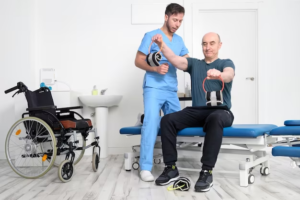Dynamic Physical Therapy (DPT) is a specialized branch of physical therapy that focuses on improving mobility, strength, and function in patients with a wide range of musculoskeletal conditions. Unlike traditional physical therapy, which often follows a fixed regimen, DPT employs a personalized, adaptive approach to rehabilitation. In this article, we will delve deep into the world of Dynamic Physical Therapy, exploring its principles, benefits, and the role it plays in restoring and enhancing physical well-being. Whether you’re seeking relief from pain or looking to optimize your performance, DPT could be the key to your success.
What Sets Dynamic Physical Therapy Apart?
Traditional physical therapy typically involves a prescribed set of exercises and treatments, often with minimal adaptation to individual needs. In contrast, Dynamic Physical Therapy places a strong emphasis on customization and adaptability. It recognizes that no two patients are the same, and therefore, no two treatment plans should be identical.
Personalization
At Dynamic Physical Therapy, every treatment plan is meticulously tailored to meet the unique needs and goals of each patient. This individualized approach is rooted in the understanding that no two patients are alike, and as such, no two treatment plans should be identical. Here’s how personalization is at the heart of DPT:
- Assessment of Comprehensive Factors: DPT therapists go beyond assessing just the physical condition of the patient. They take into account various factors, including lifestyle, activity level, and personal preferences. This comprehensive evaluation ensures that the treatment plan is not only effective but also aligns with the patient’s daily life.
- Customized Techniques: Based on the assessment, DPT therapists employ a wide range of customized techniques and modalities to address specific issues. Whether it’s manual therapy, exercise programs, or specialized equipment, each component is selected with the patient’s unique needs in mind.
- Goal-Oriented Approach: DPT sets clear, achievable goals in collaboration with the patient. These goals serve as benchmarks to track progress and ensure that the treatment plan evolves according to the patient’s changing needs and improvements.
Progressive Rehabilitation
Dynamic Physical Therapy is known for its commitment to progressive rehabilitation. This means that as a patient’s condition improves, their therapy plan is continually adjusted to provide appropriate challenges and promote ongoing strength and recovery. Here’s how progressive rehabilitation is integrated into DPT:
- Regular Assessment: DPT therapists conduct regular assessments to monitor the patient’s progress. Through objective measurements and clinical evaluations, they gauge the effectiveness of the current treatment plan.
- Adaptive Exercises: Therapy exercises and interventions are modified as needed. If a patient is making significant strides in their recovery, the therapy plan may be advanced to ensure continued growth and improvement.
- Prevention of Plateaus: By avoiding treatment plateaus, DPT ensures that patients continuously progress toward their goals, reducing the risk of stagnation or relapse.
Holistic Approach
A cornerstone of Dynamic Physical Therapy is its holistic approach to patient care. Instead of simply addressing symptoms, DPT takes into account the entire body as a dynamic system. By identifying and targeting the root causes of dysfunction, DPT promotes long-lasting improvements. Here’s how the holistic approach is integrated into DPT:
- Understanding Root Causes: DPT therapists are trained to identify the underlying causes of physical issues, considering factors such as posture, muscle imbalances, and movement patterns. Addressing these root causes is essential for sustainable recovery.
- Comprehensive Treatment: Treatment plans in DPT often include a combination of therapies, which may encompass manual therapy, therapeutic exercises, ergonomic recommendations, and lifestyle modifications. This multifaceted approach ensures that all aspects contributing to the patient’s condition are addressed.
- Preventative Education: Patients are educated about the importance of long-term maintenance and prevention of future issues. This empowers them to make informed decisions about their health and well-being beyond the duration of their therapy.
Active Patient Participation
Dynamic Physical Therapy actively involves patients in their own recovery process. This philosophy promotes self-awareness and equips patients with techniques and exercises that they can integrate into their daily lives, leading to sustained and improved physical health. Here’s how active patient participation is fostered in DPT:
- Educational Component: Patients receive comprehensive education about their condition, treatment plan, and self-care strategies. This knowledge empowers them to actively participate in their recovery journey.
- Exercise and Techniques: DPT provides patients with exercises and techniques that are tailored to their specific needs and goals. These exercises can be performed at home or during daily activities, allowing patients to take ownership of their rehabilitation.
- Long-Term Wellness: DPT encourages patients to view their recovery as a long-term investment in their health. By incorporating what they’ve learned into their daily routines, patients can maintain and even enhance their physical well-being.
The Diverse Applications of Dynamic Physical Therapy

Dynamic Physical Therapy is not limited to a specific subset of patients or conditions. It is a versatile approach that can benefit individuals across various scenarios.
Common Areas of Application
- Orthopedic Injuries: DPT can be invaluable in rehabilitating injuries to the musculoskeletal system, including fractures, sprains, and post-surgery recovery.
- Sports Injuries: Athletes often turn to Dynamic Physical Therapy to regain their peak performance after injuries or to prevent future injuries by optimizing their biomechanics.
- Chronic Pain Management: Patients with chronic pain conditions, such as lower back pain or arthritis, can find relief and improved function through DPT.
- Neurological Conditions: DPT can aid individuals with neurological conditions like stroke, multiple sclerosis, or Parkinson’s disease in improving their motor skills and quality of life.
- Preventive Care: Even if you’re not injured, DPT can help you prevent injuries by enhancing your strength, flexibility, and balance.
Dynamic Core Physical Therapy
One specialized subset of Dynamic Physical Therapy is Dynamic Core Physical Therapy, which specifically targets the core muscles of the body. These muscles are fundamental for stability and posture.
- Improved Posture and Spinal Alignment: DPT helps individuals achieve better posture and spinal alignment, reducing the risk of back problems.
- Enhanced Core Strength and Stability: A strong core supports daily activities and athletic performance while reducing the risk of injuries.
- Reduced Risk of Back Pain and Injuries: Core-focused therapy can alleviate back pain and prevent future issues.
- Better Athletic Performance: Athletes benefit from improved core strength and stability, leading to enhanced performance and reduced injury risk.
Dynamic Physical Therapy Locations
Dynamic Physical Therapy has gained prominence across the United States, with several well-regarded centers, including:
- Dynamic Physical Therapy Elkton MD: This center in Elkton, Maryland, provides high-quality Dynamic Physical Therapy services to residents in the area.
- Dynamic Physical Therapy Massapequa: Located in Massapequa, New York, this center offers comprehensive DPT services to the local community.
- Dynamic Physical Therapy Las Vegas: Serving the bustling city of Las Vegas, this center caters to the needs of residents seeking top-tier physical therapy.
The Dynamic Rehabilitation Process
To fully appreciate Dynamic Physical Therapy, it’s essential to understand the step-by-step rehabilitation process involved.
Assessment and Evaluation
At the heart of Dynamic Physical Therapy (DPT) is a thorough assessment and evaluation phase. This critical step sets the foundation for the entire rehabilitation journey. During this phase, highly trained therapists from Dynamic Physical Therapy Elkton MD or any other DPT clinic, conduct a comprehensive evaluation of the patient’s condition. Key aspects of this assessment include:
- Mobility: The therapist assesses the patient’s ability to move joints and limbs effectively.
- Strength: Muscle strength and weakness are evaluated to identify areas that require improvement.
- Flexibility: The range of motion in joints is examined to determine limitations.
- Underlying Issues: Any underlying medical conditions or injuries that may impact rehabilitation are identified.
- Patient’s Goals: Therapists engage in open communication with the patient to understand their specific goals and expectations.
This initial assessment is crucial in tailoring the rehabilitation plan to the unique needs and objectives of the patient.
Personalized Treatment Plan
Once the assessment is complete, a personalized treatment plan is meticulously crafted. This plan serves as the roadmap for the patient’s rehabilitation journey and includes:
- Specific Exercises: Targeted exercises are prescribed to address identified weaknesses and limitations.
- Modalities: Therapeutic modalities such as heat, cold, ultrasound, or electrical stimulation may be incorporated as needed.
- Interventions: Specialized interventions like manual therapy or traction may be employed to accelerate healing and recovery.
- Frequency and Duration: The plan outlines the recommended frequency and duration of each therapy session.
The treatment plan is uniquely tailored to address the patient’s condition, ensuring that every aspect of their rehabilitation is carefully considered.
Active Rehabilitation
One distinguishing feature of Dynamic Physical Therapy is its commitment to active rehabilitation. Patients play an active role in their recovery process by engaging in exercises and movements guided by their therapist. This hands-on approach fosters a sense of ownership and empowerment, allowing patients to take control of their healing journey.
- Faster Progress: Active participation often leads to quicker and more sustainable progress.
- Improved Compliance: Patients are more likely to adhere to their treatment plan when they actively contribute.
- Enhanced Functionality: Active exercises help patients regain functionality and independence.
Ongoing Monitoring and Adjustments

Rehabilitation is not static; it evolves as the patient progresses. Dynamic Physical Therapy includes continuous monitoring by therapists, who make necessary adjustments to the treatment plan. This dynamic approach ensures that the patient receives the most effective care at every stage of their recovery.
- Progress Tracking: Therapists track the patient’s performance to measure improvements.
- Adjustments: Modifications are made to exercises and interventions to adapt to changing needs.
- Preventing Plateaus: Regular adjustments help prevent progress plateaus, keeping the rehabilitation process efficient.
Education and Prevention
Dynamic Physical Therapy places a strong emphasis on patient education. Patients are not only guided through their current rehabilitation but also empowered with the knowledge and skills to prevent future issues. This educational component includes:
- Self-Care Techniques: Patients learn how to manage their condition through self-care practices.
- Preventive Exercises: Exercises and routines are taught to reduce the risk of future injuries.
- Lifestyle Recommendations: Therapists provide guidance on maintaining a healthy, active lifestyle.
By educating patients, DPT equips them with the tools they need for sustained well-being beyond their rehabilitation program.
Gradual Transition to Independence
The ultimate goal of Dynamic Physical Therapy is to enable patients to maintain their physical health independently. This transition is a gradual process, ensuring that patients are fully prepared to continue their wellness journey without constant therapeutic support.
- Gradual Reduction: The frequency of therapy sessions is gradually reduced.
- Home Exercise Programs: Patients receive personalized home exercise programs to continue their progress.
- Long-Term Maintenance: Patients are encouraged to maintain an active and healthy lifestyle to prevent relapses.
The Advantages of Dynamic Physical Therapy
Dynamic Physical Therapy offers numerous advantages over conventional approaches:
| Benefit | Description |
| Personalized Care | DPT tailors treatment plans to the individual, maximizing the chances of success. |
| Faster Recovery | The adaptability of DPT often leads to faster and more effective recovery. |
| Improved Function | DPT aims not only to reduce pain but also to enhance function and performance. |
| Injury Prevention | By addressing underlying issues, DPT helps prevent future injuries. |
| Enhanced Quality of Life | Patients often report an improved overall quality of life after DPT. |
Conclusion
Dynamic Physical Therapy is a dynamic approach to rehabilitation and performance enhancement that empowers individuals to take control of their physical well-being. With its personalized, adaptable nature, DPT offers a path to faster recovery, improved function, and an overall enhanced quality of life. Whether you’re recovering from an injury or seeking to optimize your physical performance, Dynamic Physical Therapy could be the key to unlocking your full potential. Don’t wait; explore the benefits of DPT and embark on your journey towards better health and mobility today.
FAQs
1. Is Dynamic Physical Therapy suitable for everyone?
DPT can benefit a wide range of individuals, from athletes recovering from sports injuries to people with chronic pain conditions. It’s important to consult with a therapist to determine if DPT is right for you.
2. How long does a Dynamic Physical Therapy session typically last?
The duration of a DPT session can vary depending on the individual and their specific treatment plan. On average, sessions can last between 30 minutes to an hour.
3. What should I wear to a Dynamic Physical Therapy session?
Comfortable, loose-fitting clothing that allows for movement is recommended. You may need to change into exercise-appropriate attire during your session.
4. How many sessions will I need?
The number of sessions required varies from person to person. It depends on factors like the nature of the condition, the individual’s commitment to the therapy, and their goals. Your therapist will discuss a recommended treatment plan with you.
5. Can Dynamic Physical Therapy help with weight loss?
While DPT primarily focuses on rehabilitation and performance enhancement, it can indirectly support weight loss by improving mobility and encouraging physical activity. However, it’s not a direct weight loss program.











+ There are no comments
Add yours